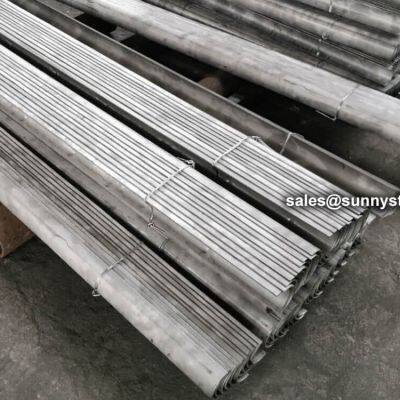
Stainless 316 Tube Shield
Product Details
Product Details
Product Description
Product DescriptionStainless 316 tube shields are made of 316 stainless steel and can be customized to fit perfectly straight sections, curved sections and even finned and specialty tubes.
Stainless steel 316 (SS316) is an austenitic chromium-nickel stainless steel containing deliberate amount of molybdenum which increases general corrosion resistance and especially improves its pitting resistance to chloride ion solutions.
Chemical Compostion of 316 stainless steel
The chemical composition of ASTM A240 Grade 316/316L Stainless Steel is outlined in the following table
| 316 | Min | - | - | - | 0 | - | 16 | 2 | 10 | - |
| Max | 0.08 | 2 | 0.75 | 0.045 | 0.03 | 18 | 3 | 14 | 0.1 | |
| 316L | Min | - | - | - | - | - | 16 | 2 | 10 | - |
| Max | 0.03 | 2 | 0.75 | 0.045 | 0.03 | 18 | 3 | 14 | 0.1 | |
| 316H | Min | 0.04 | 0.04 | 0 | - | - | 16 | 2 | 10 | - |
| max | 0.1 | 0.1 | 0.75 | 0.045 | 0.03 | 18 | 3 | 14 | - |
Mechanical and Physical Properties of 316 Stainless steel
| (MPa) min | (MPa) min | (% in 50mm) min | Rockwell B (HR B) max | Brinell (HB) max | |
| 316 | 515 | 205 | 40 | 95 | 217 |
| 316L | 485 | 170 | 40 | 95 | 217 |
| 316H | 515 | 205 | 40 | 95 | 217 |
| 316Ti | Better resistance to temperatures of around 600-900 °C is needed. |
| 316N | Higher strength than standard 316. |
| 317L | Higher resistance to chlorides than 316L, but with similar resistance to stress corrosion cracking. |
| 904L | Much higher resistance to chlorides at elevated temperatures, with good formability |
| 2205 | Much higher resistance to chlorides at elevated temperatures, and higher strength than 316 |
| ASTM A240 | ASTM A240 |
| ASTM A666 | ASTM A666 |
| ASME SA240 | ASME SA240 |
| AMS 5524 | AMS 5507 |
Grade 316 is the standard molybdenum-bearing grade, second in importance to 304 amongst the austenitic stainless steels. The molybdenum gives 316 better overall corrosion resistant properties than Grade 304, particularly higher resistance to pitting and crevice corrosion in chloride environments. It has excellent forming and welding characteristics. It is readily brake or roll formed into a variety of parts for applications in the industrial, architectural, and transportation fields. Grade 316 also has outstanding welding characteristics. Post-weld annealing is not required when welding thin sections.
Grade 316L, the low carbon version of 316 and is immune from sensitisation (grain boundary carbide precipitation). Thus it is extensively used in heavy gauge welded components (over about 6mm). Grade 316H, with its higher carbon content has application at elevated temperatures, as does stabilised grade 316Ti.
The austenitic structure also gives these grades excellent toughness, even down to cryogenic temperatures.
Shapes and specifications of tube shields
The cross-sectional shape of boiler tubes shields is mostly semi-circular (180 degrees), and there are also 120-160 degrees. It is mainly used on finned tubes (water-cooled walls); boiler tubes erosion shields are divided into direct wear-resistant shields, in-curve anti-wear shields, outer-curve anti-wear shields, side-curve anti-wear shields, s-curve anti-wear shields, etc.
>> Hot Shenzhou Horizontal 4800kn Plastic Injection Molding Machinery Moulding Machine Children Chair
>> Factory direct sale customizable food degradable high quality bamboo chopsticks
>> Vacuum Cleaner Motor Carbon Brush Holder Brush Assembly Motor Accessories Electric Tool Carbon Brush
>> Paste Mixing Kneader for Ink, Plasticine, Silly Putty, Chewing Gum, Pencil Lead with Cooling
>> Factory Wholesale Best Price Stainless Steel Electric Kettle SKD, Wate Boiler
>> High Power 8kw Metal Laser Cutting Machines for Steel/Mild Steel /Carbon Steel/Stainless Steel /Aluminum Copper Alloy
>> Reliable Dlm160 Linear Actuator for Optimal Control and Efficiency
>> 58 PCS/Min New by Container Finishing Custom Paper Cone Machine
>> High Quality Stone Crusher Machine and Accessories, Quality Solutions /OEM 939025
>> Factory Made Wholesale Puff 3d and Digital Printed Custom Combed Cotton T-Shirt For Men & Plus Size T-shirts
>> Top Quality Wholesale Vintage Pattern BBQ Cooking Leather Apron Exporter
>> Bently 3500/05
>> Industrial Welding Gas Pressure Regulators
>> Rotary Tiller 3.6L Fuel Tank Aerobs Agricultural Machine Multipurpose Tilling
>> Good strength Decorative Baseboard Heater perforated metal Covers
>> small 290 300 bbq coal charcoal ball briquette press for sale
>> Classic Retro Eyebrow Frame Glass Lens Sunglasses
>> Vertical Type Drilling Milling Machine Zx-32hc/ Zx-32PC
>> Easily Operate Generator Diesel Generator Silent Type Generator
>> Custom Dn15-Dn100 High Quality Long Handle Grey Cast Iron Ball Valve
>> Most Popular Horizontal Cylindrical Pressure Steam Sterilizer, Autoclave, Disinfect
>> Stainless Steel Slicer Potato Knife Cutting Machine Potato Chips Slicer Machine
>> Mechanical Steel Jack Handle Type Car Lifting-Jack Tool Gear Rack Lift Screw Jack Non-Hydraulic Jack
>> Mini Press Brake Machine Wc67K 40t/1600 Steel Sheet Bending Machine
>> Agricultural Power Harrow Factory High Quality Driven Rakes Machine Vertical Blade Rotary Tiller Gearbox
>> European Electric Chain Hoist 0.5-10 Ton for Heavy Lifting Overhead Bridge Crane Gantry Lift
>> HDPE Bushing High Density PE Polyethylene Conveyor Guide Rail
>> "Outdoor Oasis: Exploring Garden Square Modern Metal Party Wedding Asian-Style Gazebo Benefits"
>> Taijia Integrated Concrete Rebar Scanner Concrete Locator Concrete Rebar Detector For Concrete Cover Meter
>> HEPA Air Filter for Clean Room Projects